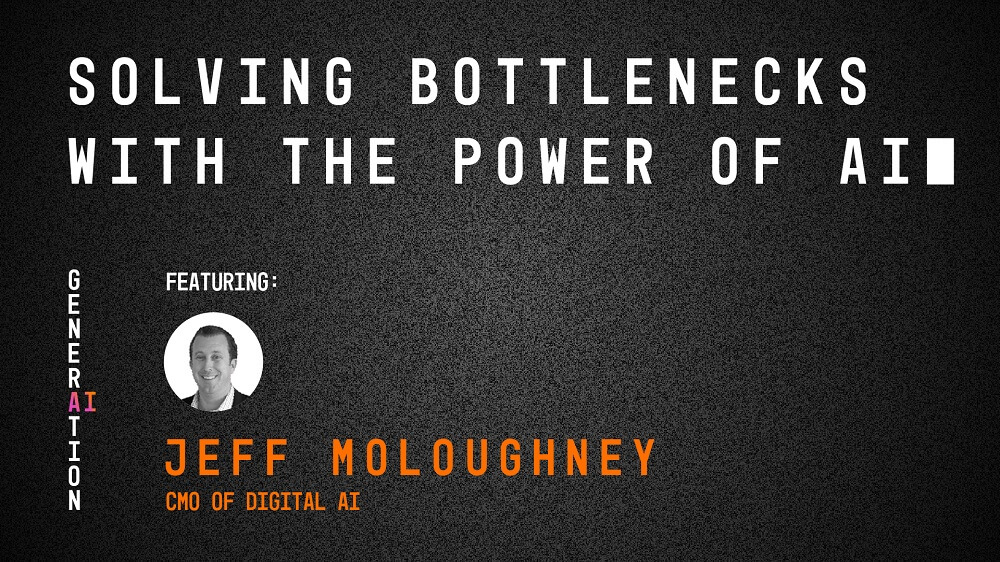PODCAST OVERVIEW
Solving bottlenecks with the power of AI business solutions
Explore how artificial intelligence can actually help us make better management-level decisions with this episode of the Generation AI podcast
September 26, 2023 • 5 minutes

The value of artificial intelligence is undeniable — but not everyone knows how to best use it. Further, in the age of increasingly accessible generative AI sparked by the explosive public launch of ChatGPT, not everyone understands what real AI actually is.
With new solutions released every day, it can be difficult for genuine AI solutions to break through the noise and convey the value and necessity of the technology.
AI’s analytical and predictive capabilities can help management teams solve a plethora of daily dilemmas — such as pinpointing and eliminating bottlenecks. Jeff Moloughney, CMO of Digital.AI, joins Ruth Zive, CMO of LivePerson, to discuss AI’s problem-solving ability in real, human terms. With better communication, artificial intelligence is set to amplify automation in a way we have never experienced.
Breaking through the hype with real AI business solutions
Having worked with many large, and now mid-sized companies, Jeff is excited about all things AI. While the hype brought around by the AI boom is incredibly promising — welcoming new minds and speedy innovation to the sphere — it can make breaking through the noise much more difficult.
To truly convey the power and meaning of your AI tools, Jeff says it’s vital to connect a genuine problem to a solution.
“AI is a very broad definition. There’s everything from natural language processing to large language models, to co-pilots,” Jeff says. “Whatever it is, you’ve really got to understand a particular business problem as a consumer and how AI can help you solve that.”
If your AI isn’t directly influencing a business outcome, it’s nearly impossible to catch the attention of the target market. By digging deep into the use case from the consumer’s point of view, it’s much easier to speak directly to the pain points your solution addresses.
“People gloss over when you use all the jargon,” Jeff says. “But when you can say, ‘I’m actually managing risk, X, Y, and Z’, or ‘I’m helping you accelerate software delivery through X, Y, and Z,’ people get it because those are problems that they have.”
Clearing bottlenecks, starting with leadership
Agile has long been making its way across organizations’ business processes, regardless of industry. But as it breaks past traditional barriers, there is one major bottleneck standing in the way of true success: leadership.
According to the 16th State of Agile Report, leadership is what hinders the process 40% of the time. Fortunately, there are many ways AI business solutions can help clear these bottlenecks for businesses to move forward quickly and efficiently.
When assessing organizations’ business functions, particularly in the enterprise space, the hierarchical organizational structure isn’t built to adapt in an iterative manner — something critical for successful Agile implementation.
Agile requires a more team-based approach where many individuals are necessary to move the business forward. Sometimes leaders with heavy experience in a traditional hierarchical setting aren’t accustomed to iterative and Agile processes, but AI can help make those connections.
“AI is the key for two reasons,” Jeff says. “First, AI is only going to add fuel into automation to make the system much more efficient. Second, AI will be able to take a lot more information and put it in a predictive stance to help somebody make a trade-off decision, which is really what management is all about.”
The power of data in addressing these bottlenecks
In today’s digital world, we’ve got an endless amount of data. When brands incorporate AI, they can leverage that data in the most effective way, ultimately breaking down data silos and allowing for the integration of useful information previously untapped.
While this data can be used for actionable business outcomes such as designing marketing campaigns and executing strategies — it’s also extremely valuable for streamlining cross-team collaboration and facilitating handoffs.
Having the ability facilitated by AI to dig into the insights better informs leadership better, allowing them to be more iterative and accelerate cycles that facilitate iterative change.
By leaning into efficiency and streamlining information and decision-making throughout critical business processes, leaders can utilize the technology behind automation and data analysis and management to become more agile. This can bypass the years of “un-learning” necessary to overcome the bottlenecks of a traditional business structure.
Breaking the narrative: Government and AI adoption
In addition to leadership and diverse organizational adoption of AI, particularly regarding the move to more Agile-centered strategies, Jeff says the government is actually better apt for keeping up with innovation than many believe.
“The government space gets a bad rap. I’ve seen government agencies or public sector areas move faster,” Jeff says. “There’s a focused group of individuals in these areas that know what they’re looking for right away and focus on solving that particular problem.”
Government can often have a better focus on solving specific problems as compared to those in the private sector. According to Jeff, AI tools have continued to help the government with planning.
“We see a lot of these government organizations adopt Agile planning practices,” he says. “They ask how they can manage portfolios, where funds are being delivered, and whether funds are serving the greater good.”
Promising AI business solutions from IT, marketing, and beyond
AI applications have no industry or team limitations — they’re being adapted effectively across companies regardless of traditional boundaries. According to Jeff, internal use cases almost always point back to data.
“Probably more importantly, AI is really resolving problems,” he says. “It goes back to the data and says, based on past history, we recognize patterns in similar problems. Then, it determines similar solutions much faster than ever before.”
Ultimately, AI is being integrated across applications to identify problems and potential solutions, giving people the competitive advantage of being able to address obstacles with greater ease. Rather than taking the role of the human, AI systems arm humans with better information, allowing them to focus on solutions for customer interactions much more quickly based on previous data.
In conclusion, employees are much more likely to solve existing problems with AI process automation on their side. Better yet — they can do so more quickly and with greater ease. When problems are addressed with increased specificity and predetermined potential solutions, the people behind an organization are also freeing up additional time and resources to focus on more intensive, novel tasks.
While AI business solutions do require governance and careful human attention, Jeff is assured that such solutions can supercharge your teams to solve the problems of tomorrow before they even arise.
Does the current state (and future) of AI technology scare or excite you?
You’re not alone! Tune in to our upcoming webinar with guest Forrester to discuss AI safety and how to use it to understand and anticipate customer needs and drive growth.

